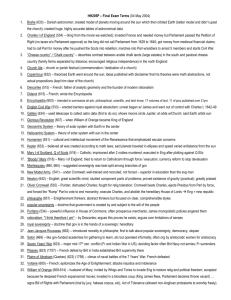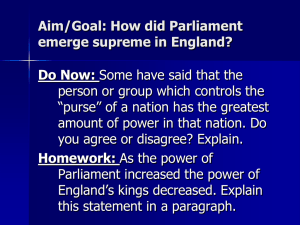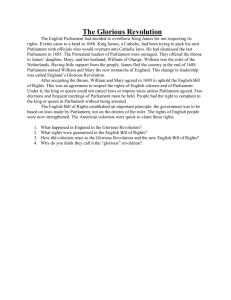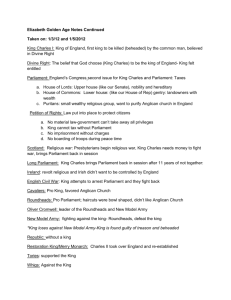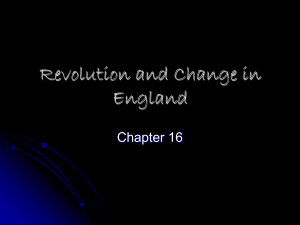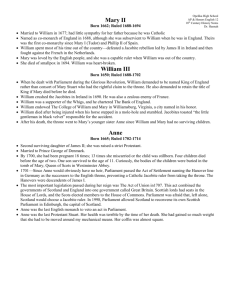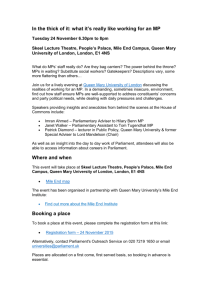The English Civil War and Glorious Revolution
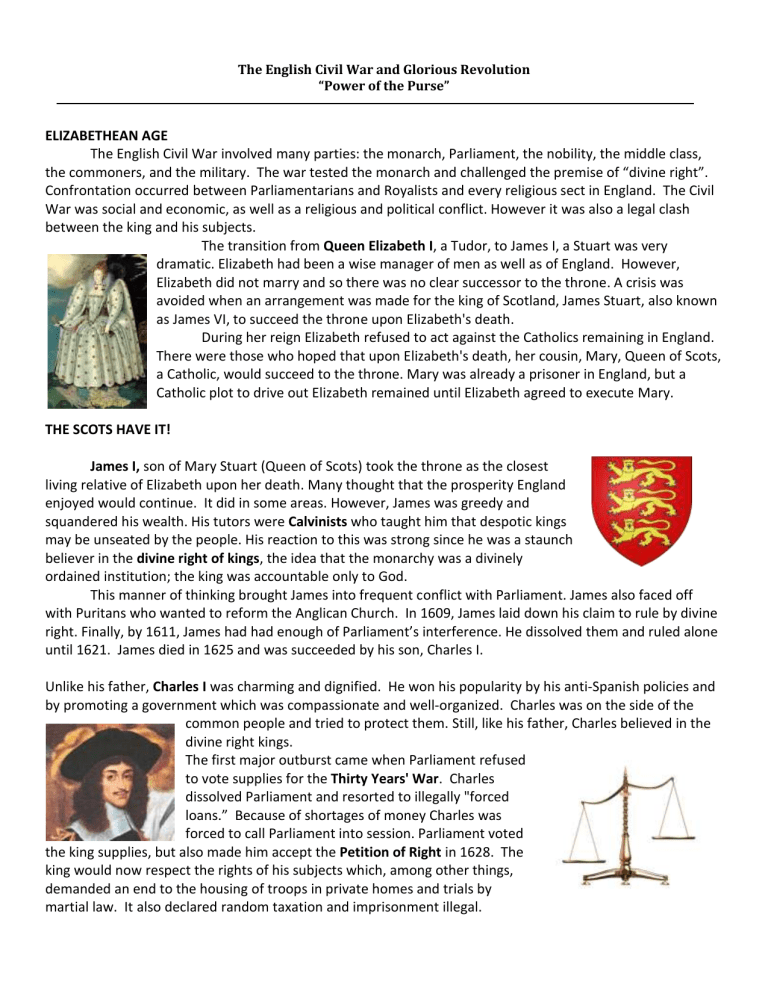
The English Civil War and Glorious Revolution
“Power of the Purse”
ELIZABETHEAN AGE
The English Civil War involved many parties: the monarch, Parliament, the nobility, the middle class, the commoners, and the military. The war tested the monarch and challenged the premise of “divine right”.
Confrontation occurred between Parliamentarians and Royalists and every religious sect in England. The Civil
War was social and economic, as well as a religious and political conflict. However it was also a legal clash between the king and his subjects.
The transition from Queen Elizabeth I, a Tudor, to James I, a Stuart was very dramatic. Elizabeth had been a wise manager of men as well as of England. However,
Elizabeth did not marry and so there was no clear successor to the throne. A crisis was avoided when an arrangement was made for the king of Scotland, James Stuart, also known as James VI, to succeed the throne upon Elizabeth's death.
During her reign Elizabeth refused to act against the Catholics remaining in England.
There were those who hoped that upon Elizabeth's death, her cousin, Mary, Queen of Scots, a Catholic, would succeed to the throne. Mary was already a prisoner in England, but a
Catholic plot to drive out Elizabeth remained until Elizabeth agreed to execute Mary.
THE SCOTS HAVE IT!
James I, son of Mary Stuart (Queen of Scots) took the throne as the closest living relative of Elizabeth upon her death. Many thought that the prosperity England enjoyed would continue. It did in some areas. However, James was greedy and squandered his wealth. His tutors were Calvinists who taught him that despotic kings may be unseated by the people. His reaction to this was strong since he was a staunch believer in the divine right of kings, the idea that the monarchy was a divinely ordained institution; the king was accountable only to God.
This manner of thinking brought James into frequent conflict with Parliament. James also faced off with Puritans who wanted to reform the Anglican Church. In 1609, James laid down his claim to rule by divine right. Finally, by 1611, James had had enough of Parliament’s interference. He dissolved them and ruled alone until 1621. James died in 1625 and was succeeded by his son, Charles I.
Unlike his father, Charles I was charming and dignified. He won his popularity by his anti-Spanish policies and by promoting a government which was compassionate and well-organized. Charles was on the side of the common people and tried to protect them. Still, like his father, Charles believed in the divine right kings.
The first major outburst came when Parliament refused to vote supplies for the Thirty Years' War. Charles dissolved Parliament and resorted to illegally "forced loans.” Because of shortages of money Charles was forced to call Parliament into session. Parliament voted the king supplies, but also made him accept the Petition of Right in 1628. The king would now respect the rights of his subjects which, among other things, demanded an end to the housing of troops in private homes and trials by martial law. It also declared random taxation and imprisonment illegal.
THE COMMONWEALTH
Charles I on November 3, 1640 once again summoned Parliament in the hope to raise money to finance his war in Scotland. Charles accepted that the Long Parliament was not going to be cooperative and he began to build an army to counteract them. At first,
Parliamentary forces (Roundheads) were routed until 1644, at Marston Moor, where the
King’s forces (Cavaliers) were stopped. In 1645, the "New Model Army" defeated Charles’ forces. The New Model Army was built on a soldier’s ability rather than on his position within society. Worth, not birth or social class became the only criteria for membership.
The inspirational force of the New Model Army was Oliver Cromwell. He was a
Puritan who belonged to the English ruling class and came from a family that wielded enormous power. He worked to support authority and believed that class division was the cornerstone of a society. Cromwell believed in religious freedom and tolerance.
However, he sincerely believed that God had chosen him to lead. He even attributed his military victories to God rather than to his own strategy and tactics.
With Cromwell’s victory, Charles I, King of England was charged as a traitor, murderer, and enemy to the Commonwealth. One hundred and thirty-five judges were to hear evidence at his trial, only half that number showed up due to hidden threats.
Cromwell only allowed people into Parliament who supported the trial. This was known as the Rump Parliament. Cromwell first opposed bringing the king to justice but then took a principal role at his trial. A guilty verdict was reached on January 20th. Seven days later, he was sentenced. A death warrant was issued and signed and on the following morning, Charles I was executed. His son Charles II had been sent abroad to shelter him from prosecution and possible death.
With the death of Charles, the monarchy was abolished. Cromwell became "Lord Protector of the
Commonwealth”. Cromwell's regime was based on power, not on the will of the citizens. It became a dictatorship which eventually was opposed by the majority of the country. Virtually everyone in England by
1660 was tired of the Puritan experiment in leadership. Charles II was brought back from the Spanish
Netherlands without bloodshed to restore the monarchy.
RESTORATION
After four decades of parliamentary and military strife, Charles II returned to
England (Restoration). He was not a popular king. He was wrapped up in the luxurious life at court, he had numerous mistresses and many believed he was also a
Roman Catholic.
As a reaction to Puritan tyranny under Cromwell, the English restored too much autocratic power to the king. The result was that political and religious liberties had to be rescued yet again.
WHO’S TO RULE?
Charles II had no legitimate children. He did have a brother, James II, Duke of York, but James was Catholic and since England was mostly Protestant and anti-
Catholic, this would eventually turn out to be a political failure. Political factions like the Tories emerged to uphold the legitimate rights of James to succeed his brother to the British throne, whereas, the Whigs, opposed the hereditary ascent of James. Nevertheless, James II became King of England, but flaunted his
Catholicism. He appointed Catholics to high government offices, despite a law that barred Catholics from holding office. Parliament protested his actions and his reaction was to dissolve them. Many English feared there would be a succession of Catholic kings. James had a Protestant daughter, Mary, who wed William of
Orange, a Protestant prince from the Netherlands. Parliament secretly asked them to come to England with an army to overthrow James in the name of Protestantism. William and Mary took the throne in what is called the Glorious Revolution, a bloodless takeover.
GLORY! GLORY!
The Glorious Revolution checked the power of the monarchy, and paved the way for the rise of cabinet government and parliamentary democracy, and resulted in the English Bill of Rights--some of whose provisions (such as those forbidding cruel and unusual punishments, excessive fines, or excessive bail) later found their way into the American Bill of Rights and our Federal Constitution.
The Glorious Revolution was the political and governmental upheaval that shook England in 1688.
Through a remarkable series of jolting events King James II, England’s last Roman Catholic sovereign, lost his throne in December 1688; and the English crown was transferred to his own son-in-law and daughter respectively, William and Mary, Prince and Princess of Orange in the Netherlands, who on Feb. 13, 1689 began ruling England jointly as King William III and Queen Mary II.
The Glorious Revolution, a swift, bloodless, and one of the mildest revolutions in history, began in the spring of 1688 with several conspiracies against James II by his political enemies and various military officers, and became irresistible by Nov. 5, when the Prince of Orange’s invasion fleet appeared off the coast of
Devonshire in western England and began landing an army in what history records as the last successful invasion of England. It is said James II was in the presence of his courtiers when he opened and read the dispatch confirming William’s landing. All the blood is said to have left his cheeks, and he dropped the dispatch and was speechless for some time.
The Glorious Revolution ended three months later on Feb. 13, 1689, when William and Mary were officially proclaimed the new monarchs in London by a convention specially assembled in lieu of a Parliament.
By then the deposed James II was living in exile in France, a guest of French King Louis XIV.
Some Events in the Miraculous Year 1688
When the year 1688 began, King James II was 54 years old, prematurely aged, one of those dull, stubborn persons who cannot learn from their mistakes. He had been on the throne for three years. As the year progressed,
James committed a series of major blunders and illegalities which steadily eroded his political support, leaving him isolated and unpopular.
In April 1688 James provoked the crisis by issuing a royal proclamation purporting to suspend enforcement of certain laws duly enacted by Parliament.
He also announced his intention of filling up government offices with fellow
Catholics, even though Catholics were disqualified from holding offices under anti-Catholic laws then on the books.
In May 1688 James II aggravated matters by ordering the Church of England to read the royal proclamation during divine services. On Friday, May 18 the 77-year old Archbishop of Canterbury, William
Sancroft, and six other Anglican bishops privately presented the King with a respectful petition begging to be excused from this. James flew into a rage. When the proclamation was not read in the churches as he had directed, James had the Seven Bishops (as they were soon known) arrested on Friday, June 8 and confined in the Tower of London for exactly one week, then released on bail to await trial on misdemeanor charges for having presented their petition to the King. To James II, humble petitioning was seditious libel. The arrest, imprisonment, and prosecution of the bishops amazed the English people.
The Trial of the Seven Bishops in the Court of King’s Bench was the greatest and most memorable common law trial in history.
The trial began on Friday, June 29, and amidst cheers the jury returned a verdict of acquittal the next day. The acquittal was widely viewed as a crushing rebuke to James II, whose predictable comment on the acquittal was: “So much the worse for them.”
While the bishops were in the Tower another unexpected event happened. James II was thought to be “diseased,” and his wife was thought incapable of having healthy children and also thought not to be pregnant. But suddenly Queen Mary of Modena, James’s wife and England’s only Italian queen, gave birth to a boy on Sunday,
June 10. Since the baby was sure to be raised Catholic, the people of England now faced the grim prospect that James II’s unpopular and unlawful policies would survive him. (Prior to the boy’s birth, the first in line to the throne was Mary, Princess of Orange, James’s eldest and Protestant daughter by an earlier marriage.)
William of Orange Invades England
Meanwhile, across the water in Holland, William, Prince of Orange, was carefully following events in England and secretly contemplating the possibility of dethroning James II. William knew that if somehow he could ascend the English throne, he would be in a position to cause England to join-on the side of the coalition against France. William was married to Mary, the daughter of James II. Until the birth of James II’s son on June 10, Mary was first in line to the English throne. William had long been closely involved in English politics with English politicians. By 1688 he had become the acknowledged leader of much of James II’s political opposition.
Unlike James II, who was tall, handsome, and fair, William was short, sickly, and noted for his aquiline nose. William was one of the greatest of all European statesmen. His life was dedicated to humbling the might of France and the glory of Louis XIV, his deadliest enemy. As fellow Catholics, Louis XIV and James II were close allies.
In May 1688 a representative of one of the conspiracies against James II paid a secret visit to William at the
Hague. William was not asked to dethrone James II. He was asked to come over to England with soldiers to rescue the people from the oppression of James II. William replied that if he were specifically invited by a sufficient number of important Englishmen, he thought he could be in England by September.
On June 30, the very Saturday the Seven Bishops were found not guilty, that invitation, signed by seven
English politicians later known as the Immortal Seven, was dispatched to William by secret courier. William immediately ordered military and naval preparations for the invasion of England. He remained silent concerning his secret intention to dethrone James II.
William’s fleet of 50 warships and 300 transports carrying 7,000 sailors, 14,000 troops, 4,000 horses, and hundreds of tons of supplies, set sail from Holland on Thursday, November 1. William himself sailed on board a warship that led the fleet. The winds blew favorably, and soon the invasion fleet was in the North
Sea. Avoiding the English fleet sent to intercept it, the Dutch fleet sailed through the English Channel on
Saturday, Nov. 3, and on Monday, Nov. 5, arrived off Torbay, in Devonshire (in the West of England), where the army immediately disembarked.
The story is told that upon setting foot on land, William, a gloomy Calvinist who seldom wisecracked, turned to his chaplain and joked: “Well, Doctor, what do you think of predestination now?” Once his army was safely on English soil, William began an unhurried march toward London, less than 200 miles away. Support for William grew all over the country, while support for James II evaporated. Many of James II’s supporters fled to the continent, while others retired to their homes and laid low. After his leading military commanders and many other military or civilian officers deserted to William in late November and early December, James II decided to send his wife and 6-month old baby in secrecy to France. James’s wife, Queen Mary of Modena, left the palace around 2:00 a.m. on Monday, Dec. 10, 1688, a cold, windy, and rainy night. She carried her infant son in her arms and was attended by a handful of servants and escorts. The following night, after confirming that his wife and son had safely sailed for France, James II burned the Parliamentary writs, picked up the Great Seal of England, and the slipped out of his palace and began his own attempt to flee to France.
The King of England Seized by Fishermen
Queen Mary of Modena made it safely to France, but he King’s attempt to flee failed in humiliating fashion. Late that Tuesday morning, Dec. 11, the King on horseback arrived at the Kentish coast and boarded a small sloop; but because of strong winds the pilot refused to sail. Shortly before midnight, just as the sloop was finally about to sail, 50 armed fishermen in three fishing boats suddenly approached the sloop, boarded it, and captured, robbed, and insulted the persons on board, including the disguised King, who was not recognized. At gunpoint the King of England was made to turn out his pants pockets.
On the morning of Wednesday, Dec. 12, the King and his party were taken to a nearby fishing village, where the King was recognized and they were detained in a private house until Saturday, Dec. 15.
During the time he was detained, James II suffered a nervous breakdown. He wept. He beseeched.
He even feigned happiness. One who saw the King in the village wrote: “I observed a smile on his [the King’s] face, of an extraordinary size and shape, so forced, awkward, and unpleasant to look upon, that I can truly say
I never saw anything like it.”
James II Successfully Escapes to France
James II returned to his palace in London on Sunday, Dec. 16. Two days later he was required to leave town by William. Shortly after the King left London for the last time, William entered London, and was
received as a liberator. Among other deputations, a group of distinguished lawyers came to greet William once he was lodged in St. James’s Palace, where James II’s son had been born six months earlier, and where
William had married Mary back in 1677. Speaking to John Maynard, a famous 90-year old lawyer, William said complimentarily: “Sir, you must have survived all the lawyers of your time.” Maynard’s brilliant reply impressed everyone present: “And had Your Highness not come over, I should have survived the laws too.”
James II went to Rochester, where for a week he remained an honorable prisoner in a home now known as Abdication House. In the early hours of Sunday, Dec. 23, James II again arose from a bed at dead of night, stole out a back door, rode on horseback to the seacoast, and boarded a smack--a single-masted mackerel fishing boat--which conveyed him to the French coast. He and his few attendants arrived near Calais on the following Tuesday, Christmas day.
The deposed James II remained in French exile until his death in 1701. He was the last English sovereign to claim to rule by divine right.


